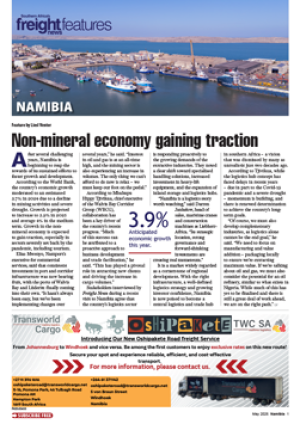The air cargo business has
certainly come a long way in
the last 40 years. But where
might it go in the next 40?
At present, times are tough for air
freight. In terms of tonnes carried,
air cargo has been flat-lining. Since
2010 total freight tonnes carried
have grown by just 1.4 million. Yields
were negative last year and will
probably fall again in 2013, while
the freight load factor for the year is
running at just 45%.
Yet in 2012 air cargo transported
goods worth $6.4 trillion. That’s
35% of the world’s traded goods by
value. It shows how essential air
freight is to the modern world. And
looking to the future, I believe that
air cargo will continue to be a crucial
sparkplug in the global economic
engine, but that a revolution in global
manufacturing is coming which will
have significant implications for our
business.
It is impossible to be sure how
the global economy will develop in
the next 40 years, but in particular
there are two trends that could
have a major impact on air cargo:
repatriation of manufacturing,
and 3D printing. The shale oil/
gas revolution has brought energy
costs down so much that it has
made the US competitive again.
Manufacturing is coming home, and
the same could happen in Europe.
What could be the consequences?
Less air freight from East to West
would be a concern. But on the other
hand, exports back to the Far East
could increase, ensuring some of the
empty bellies that return to China,
Japan and elsewhere are filled.
With regard to 3D printing, at
present it is a niche. But already a
machine can be bought for a few
hundred dollars that can print
anything from shoes to jewellery.
Only simple, low-tech items can be
printed at the moment, but as this
technology develops there is no doubt
that it is going to impact every aspect
of manufacturing.
So we face a future of great
change and uncertainty. To
compete, air cargo needs a complete
transformation.
E-freight is the key. The cynical
may wonder if we will be doing an
FTW retrospective in another 40
years’ time and still be talking about
e-freight! There is no doubt that it
has been a long time coming. But
I am firmly of the belief that we
are close to the critical momentum
that is going to deliver this essential
transformation to our business. The
creation of the multilateral e-AWB
in May has started to drive e-AWB
implementation. And the e-AWB is
the cornerstone of e-Freight.
If air cargo is to have a prosperous
future, it needs to re-invigorate
itself and commit to speeding up
shipment times and raising reliability
levels even higher. We have the tools
in place to achieve this – we just
need the vision and the leaders to
implement it.
INSERT & CAPTION
To compete, air cargo
needs a complete
transformation. That
means improving speed and
reliability while reducing
costs.
– Des Vertannes

